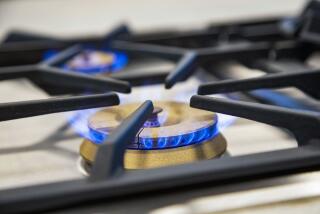Out of the Fire and Into the Frying Pan and Other Wares
Gary Larson probably settled the great cookware genesis controversy in one of his “Far Side” cartoons, in which a group of Neanderthals (real ones) are seen cooking mastodon cutlets, or something, by simply hanging onto them and thrusting them into a fire. Their faces are contorted in pain. Nearby, one of their number has stuck his portion of the meat on a stick and is cheerfully roasting it like a hot dog. An observer calls attention to this.
“Hey,” he says, the light bulb going on. “Look what Thag do!”
And so an industry was born.
Today, the most satisfying method of cookery is still the alfresco hot dog on a stick (no matter what the French say), but the sad fact is that most of us eventually will get curious and go indoors and start trying to figure out what that thing in the kitchen that makes fire is for. Eventually, we will sort it out, and our Visa bills will instantly leap skyward. We will start to invest in cookware.
Make no mistake, said Jeannie Sloan, the manager of Williams-Sonoma in MainPlace/Santa Ana, decent cookware is an investment. Still, if you are at all serious about cooking good food, you’ll want to apply heat to it with gear that suits you. Many of Sloan’s customers, she said, are nearly fanatical about this, but it pays.
And speaking of paying, here’s a look at the top of the line, as well as a few of its relations, poorer and otherwise:
Copper--The full-gonzo mixed blessing of the cookware world, copper is gorgeous to look at, spectacular to display and, said Sloan, “the finest metal you can cook in as far as heat distribution.”
It also costs a bundle and can be hell to keep shiny. Still, it’s considered to be the best, if not the most practical for heavy daily use. If you’re thinking of buying it, heft it. Cheaper, light-gauge copper won’t last. Also, make note of whether the pots and pans are lined with tin or, more recently, stainless steel. The lining is there to protect you; acidic foods that come in direct contact with copper can produce toxins, according to the cooking technique bible “La Varenne Pratique.”
High heat may cause tin to melt and expose the copper, and if this happens the utensil must be thrown out or re-tinned, which is expensive. Stainless steel, however, can take the high heat. Copper tarnishes easily, and commercial copper cleaners are available. However, according to “The Joy of Cooking,” a vinegar-and-salt solution also works.
Aluminum--Relatively inexpensive, but can be hard to control, Sloan said. The cheaper stuff is quite light, but the thinness of the metal can cause heat to transfer too quickly for some cooking, and hot spots can develop. Subjected to rapid changes of temperature, thin aluminum can even warp, she said.
Raw aluminum, now relatively uncommon, is also reactive and can impart a metallic taste to food. More recently, the use of raw aluminum was discouraged for fear of a connection between exposure to aluminum and Alzheimer’s disease. However, the results of an Oxford University study, released in January, indicated that aluminum found in Alzheimer’s brain samples came from airborne dust that contained aluminum, and not from other sources.
Actually, one of the most popular--and pricey--brands of cookware on the market is Calphalon, which is a dark, anodized aluminum. The anodizing process coats the raw aluminum and, Sloan said, provides excellent, even heat absorption and doesn’t require a high flame to produce high heat. Also, it doesn’t react with acids. This stuff is heavy gauge and very difficult to damage so, Sloan said, “it’s great if you have kids in the house.”
Stainless steel--Another mixed blessing. Easy to keep clean, attractive to display, non-reactive, but not a great heat conductor. The best of this type of cookware features a layer of copper sandwiched into the base of each pot or pan to more evenly conduct heat.
Cast iron--Manly stuff. Heavy, inexpensive, ideal for long, slow cooking. Sloan said many of her customers wouldn’t part with their cast iron cookware at gunpoint. Wonderful heat conductivity, but this cookware requires seasoning, and it will discolor acidic foods, according to “The Joy of Cooking.” It can also rust and, according to “La Varenne Pratique,” it can crack if dropped. Still, Sloan said, it infuses cooked food with iron, which is good for you.
Enameled cast iron--The fine heat conductivity of iron without the reaction or the rusting. Very attractive stuff, but the colored enamel can chip and, Sloan said, the big pieces can weigh as much as 10 pounds.
Enamelware--This is steel covered in enamel. Not terrifically expensive but doesn’t conduct heat well and can easily chip, Sloan said. Beautiful for display, but “La Varenne Pratique” recommends it “only for boiling and poaching.”
Tempered glass and porcelain enamel--Poor heat conductors, they also tend to crack. However, once they’re hot they retain heat well and are good for long, slow cooking over low heat.
Non-stick plastic--Teflon and its cousins. You can cook on this stuff without oils or fats and it doesn’t affect the heat distribution of the metal it coats. Like enamel and porcelain, however, it must be cleaned with non-abrasive cleaner and only wooden or plastic utensils should be used with it.
A stick--Perfect for the budget-conscious, but heat distribution is affected by its tendency to suddenly ignite. Unwieldy with soups, but particularly good with mastodon cutlets.
How Much Is That Pan?
The cost of cookware varies with the material used to make it. Here is a sampling of representative prices for a 10-inch omelet pan:
Type Price Copper $100 Stainless steel $90 (with inlaid copper) Enameled cast iron $75 Anodized aluminum $50 Enamelware $50
More to Read
Eat your way across L.A.
Get our weekly Tasting Notes newsletter for reviews, news and more.
You may occasionally receive promotional content from the Los Angeles Times.









